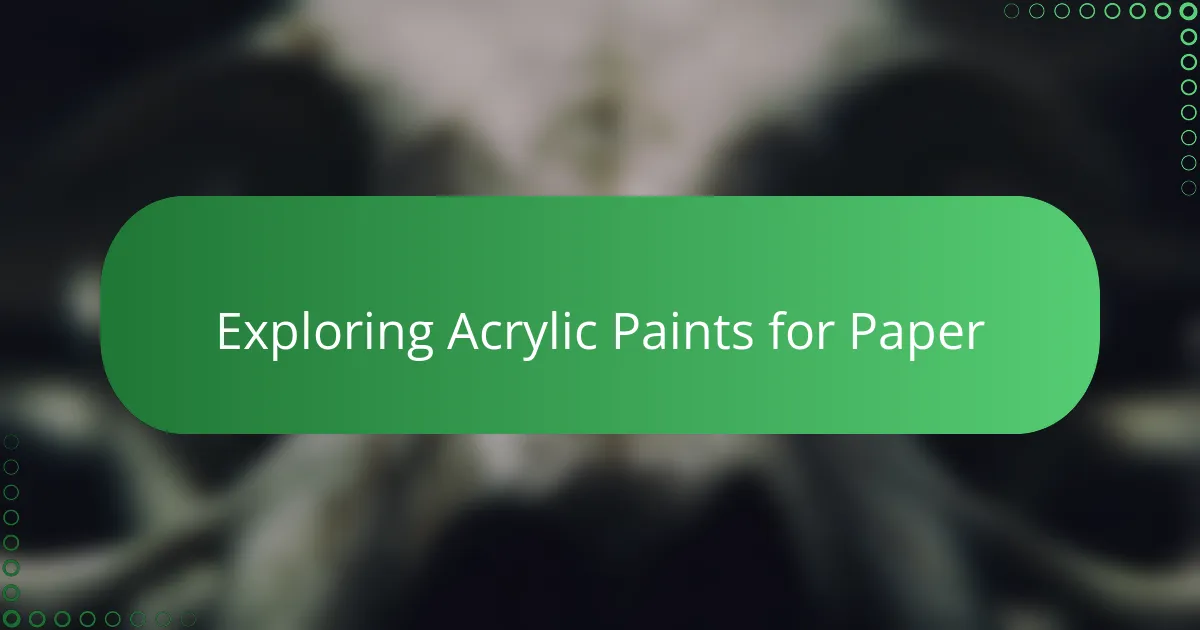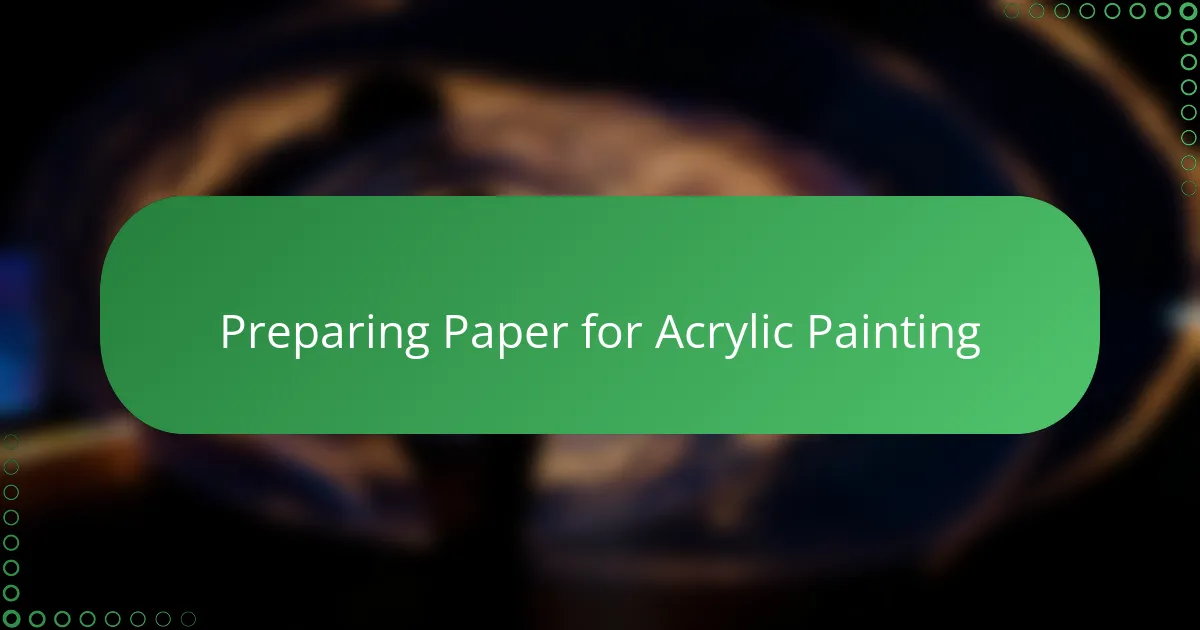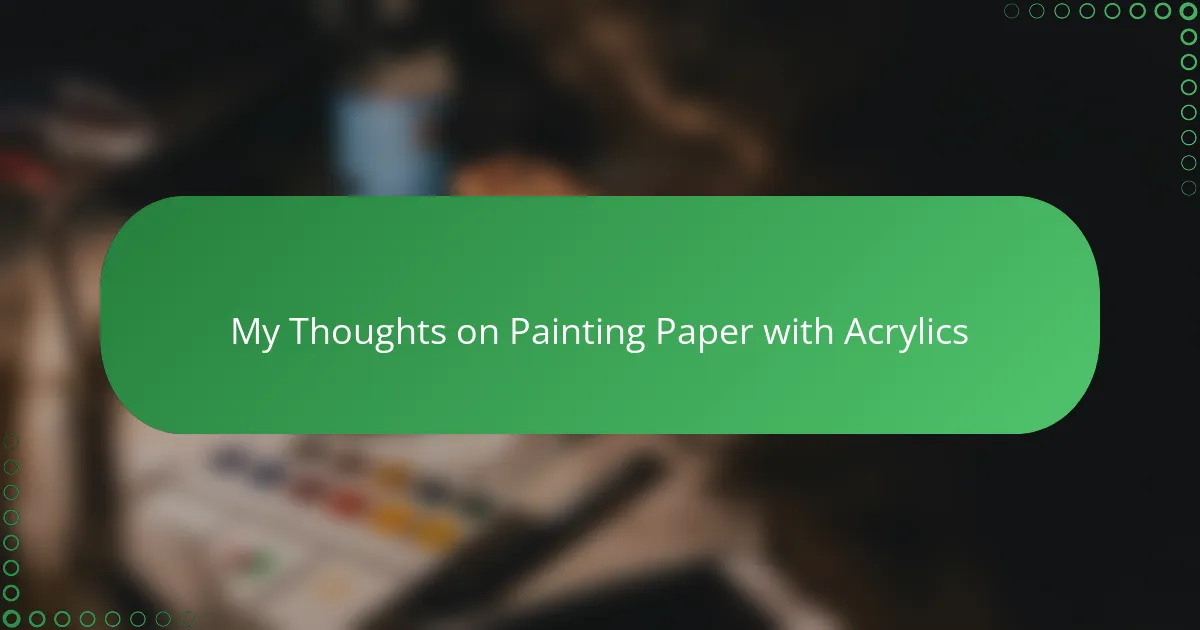Key takeaways
- Handmade paper offers unique textures that enhance artistic expression through its imperfections.
- Using acrylic paints on handmade paper requires techniques like dilution and layering to maintain the paper’s character and prevent warping.
- Preparing the paper with gesso creates a stable surface, allowing for better paint application and color vibrancy.
- Embracing imperfections in the painting process can lead to unexpected and rewarding artistic discoveries.

Understanding Handmade Paper Crafts
Handmade paper crafts have always fascinated me because each sheet carries a unique texture and character that machine-made paper just can’t replicate. Have you ever noticed how handmade paper seems to tell a story with its subtle imperfections? Those fibers, wrinkles, and sometimes uneven edges connect you to the craftsperson’s hands in a way that feels deeply personal.
When I first tried working with handmade paper, I was surprised by how much it influenced my approach to art. Unlike smooth commercial paper, handmade varieties demand careful handling and thoughtful layering, especially when using acrylic paints. This tactile experience makes every piece feel alive and one-of-a-kind—something I find truly inspiring.
Isn’t it amazing how understanding the paper itself can change the way we create? Knowing the origin, texture, and absorbency of handmade paper lets us appreciate the craft on a whole new level. It’s more than just a canvas—it’s a collaborative partner in the creative process.

Exploring Acrylic Paints for Paper
Exploring acrylic paints for paper revealed some surprising joys for me. I quickly realized that acrylics, with their vibrant pigments and quick-drying nature, offer a versatility that feels just right for handmade paper’s texture. Have you ever noticed how the paint seems to sink differently into those fibers? That unpredictability keeps me curious and engaged every time I paint.
At first, I worried the acrylic might be too harsh or heavy for delicate handmade paper, but I found that diluting the paint with a bit of water softens it just enough. This technique lets the color flow gently without overpowering the paper’s natural grain. It’s like a dance between the paint and the paper, each respecting the other’s boundaries while creating something new.
One thing I love about acrylics is how they let me layer colors without waiting long. With handmade paper, each brushstroke feels intimate, almost like a conversation between me and the surface beneath. Have you tried letting one layer dry before adding another? The depth and richness that emerge make me appreciate acrylics even more as a medium for my paper crafts.

Preparing Paper for Acrylic Painting
Preparing paper for acrylic painting is an essential step that I can’t overlook. I always start by sealing the surface with a thin layer of gesso, which acts like a protective shield to prevent the paint from soaking in too much and weakening the paper fibers. Have you ever noticed how unprepared paper can curl or buckle under wet paint? That’s exactly what I’m trying to avoid.
I remember my first project where I skipped this step and ended up with warped sheets that made finishing a struggle. Since then, applying gesso feels like a small ritual—it gives me confidence that the paper will hold up while I experiment boldly with colors and textures. It’s an act of respect for the paper’s delicate nature.
Sometimes I also lightly sand the dried gesso layer to create a smoother surface. Though handmade paper has its beautiful texture, smoothing certain areas lets me control how the acrylic settles, offering a perfect balance between preserving handmade charm and achieving my painting goals. Do you think of your paper as an active participant in your art? Preparing it properly makes me feel like we’re collaborators from the very start.

Techniques for Painting Paper with Acrylics
When I first started experimenting with painting techniques on handmade paper, I discovered that using dry brushing creates such a lovely, textured effect. Have you ever tried lightly dragging a nearly dry brush across the paper’s surface? It highlights those unique fibers and wrinkles without drowning them in color, letting the paper’s character shine through.
Another approach I’ve found helpful is layering washes of diluted acrylics. By thinning the paint with water, I can build up subtle gradients and soft color transitions that almost feel like watercolor but with the vibrancy acrylics offer. This slow layering invites me to be patient and really listen to what the paper wants to become.
Sometimes, I enjoy mixing in texture mediums with the acrylics to add dimension and tactile interest. It’s fascinating to watch how these mediums interact with the handmade paper, enhancing rather than overshadowing its natural grain. Have you noticed how adding texture changes not only the look but the whole feeling of your artwork? It’s a playful way to deepen my connection with each piece.

Common Challenges and Solutions
One challenge I often face when painting handmade paper with acrylics is managing the absorbency of the paper. I’ve learned the hard way that without proper sealing—like applying a layer of gesso—the paint soaks in too quickly, leaving dull, lifeless colors and sometimes causing the paper to buckle. Have you ever had your paint vanish into the fibers like that? Using a sealed surface completely changed my results, making the colors pop and keeping the paper stable.
Another obstacle that surprised me was dealing with warping. The delicate nature of handmade paper means it’s prone to curling or rippling once wet. I found that working in thin layers and letting each fully dry before applying another helps prevent this. Patience here isn’t just a virtue; it’s a necessity. It feels a bit like having a conversation with the paper—waiting for it to respond before moving ahead.
Sometimes, I struggle with preserving the paper’s texture while still getting smooth color coverage. At first, I wanted to coat every inch evenly, but that ended up masking the paper’s beautiful character. I started experimenting with dry brushing and mixing mediums to enhance dimension without losing that tactile feel. Have you tried embracing the paper’s imperfections rather than fighting them? That mindset shift made painting handmade paper feel less like a challenge and more like a rewarding collaboration.

Personal Experiences with Acrylics on Paper
When I first brushed acrylics onto handmade paper, I was struck by how alive the interaction felt. The paint didn’t just sit on the surface; it melded with the fibers, almost as if the paper was breathing with each stroke. Have you ever sensed that kind of connection with your tools? For me, this made each painting session feel less like applying color and more like nurturing a living canvas.
Sometimes the unpredictability of acrylics on paper frustrated me, especially when a washed-out patch appeared unexpectedly. But looking back, those surprises taught me to embrace imperfection—and to see every blotch or texture as part of the story I’m telling. It’s funny how what I once viewed as mistakes became some of my favorite elements in the finished piece.
I also recall moments when layering acrylics created depth I hadn’t anticipated. Waiting for each layer to dry tested my patience, yet the payoff was undeniable: colors that seemed to glow from within the handmade sheets. Doesn’t that feel like a small victory, proving that with a little care, acrylics and paper can truly become partners in art?
